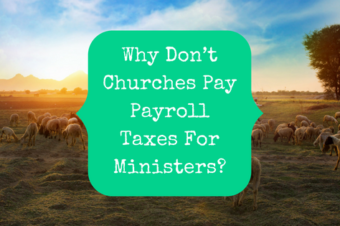
Now that the GOP tax reform bill is finalized, how does it affect pastors? Let’s take a look at the changes being enacted into law and how they might affect you.
We finally have a tax bill that has passed both houses of Congress and is now on its way to the President’s desk. After several different versions of the bill and multiple votes, it is finally done.
Now comes the part where we all try to figure out how it impacts our own personal lives and our finances. Hopefully, I can help you with that. While I don’t know every unique aspect of your situation, here are the changes that are most likely to affect you:
Clergy Housing Allowance
Probably the most significant thing for you as a pastor is what isn’t in the bill. It makes no mention of the clergy housing allowance, the biggest tax break for pastors. Therefore, you can rest easy knowing that your housing allowance will not be taken away from you or change in any form.
Tax Brackets
There will still be 7 individual tax brackets, but they have been lowered. They are now:
| Married, Filing Jointly | |
| If Taxable Income Is… | The Tax Is… |
| Not over $19,050 | 10% of taxable income |
| Over $19,050 but not over $77,400 | $1,905 plus 12% of the excess over $19,050 |
| Over $77,400 but not over $165,000 | $8,907 plus 22% of the excess over $77,400 |
| Over $165,000 but not over $315,000 | $28,179 plus 24% of the excess over $165,000 |
| Over $315,000 but not over $400,000 | $64,179 plus 32% of the excess over $315,000 |
| Over $400,000 but not over $600,000 | $91,379 plus 35% of the excess over $400,000 |
| Over $600,000 | $161,379 plus 37% of the excess over $600,000 |
| Head of Household | |
| If Taxable Income Is… | The Tax Is… |
| Not over $13,600 | 10% of taxable income |
| Over $13,600 but not over $51,800 | $1,360 plus 12% of the excess over $13,600 |
| Over $51,800 but not over $82,500 | $5,944 plus 22% of the excess over $51,800 |
| Over $82,500 but not over $157,500 | $12,698 plus 24% of the excess over $82,500 |
| Over $157,500 but not over $200,000 | $30,698 plus 32% of the excess over $157,500 |
| Over $200,000 but not over $500,000 | $44,298 plus 35% of the excess over $200,000 |
| Over $500,000 | $149,298 plus 37% of the excess over $500,000 |
| Individual | |
| If Taxable Income Is… | The Tax Is… |
| Not over $9,525 | 10% of taxable income |
| Over $9,525 but not over $38,700 | $952.50 plus 12% of the excess over $9,525 |
| Over $38,700 but not over $82,500 | $4,453.50 plus 22% of the excess over $38,700 |
| Over $82,500 but not over $157,500 | $14,089.50 plus 24% of the excess over $82,500 |
| Over $157,500 but not over $200,000 | $32,089.50 plus 32% of the excess over $157,500 |
| Over $200,000 but not over $500,000 | $45,689.50 plus 35% of the excess over $200,000 |
| Over $500,000 | $150,698.50 plus 37% of the excess over $500,000 |
How do these compare to what we have been used to? Michael Kitces of The Nerd’s Eye View blog at kitces.com put together the very helpful illustration below. The green shows where rates will be lower and the red where they will be higher.
While rates are higher for some individual taxpayers, that doesn’t mean they will necessarily be paying more in taxes. The lower rates on the first part of their income will help to offset the higher rates once they get above $200,000.
These tax cuts are not permanent. They have only been enacted into law until 2025. So, while most people will save money under the new bill, it will only last until 2025 unless extended.
Standard Deduction & Personal Exemptions
One of the major reforms is the consolidation of the standard deduction and personal exemptions. There will now be a single larger standard deduction.
The individual standard deduction increases from $6,350 to $12,000. The standard deduction for married couples increases from $12,700 to $24,000. The “additional standard deduction” of $1,250 for people who are blind or over age 65 will still apply. Let’s see what this means:
Example 1: A single adult.
Current Tax Law:
$6,350(standard deduction) + $4,050 (personal exemption) = $10,400
New Law:
$12,000 standard deduction ($1,600 greater)
Example 2: Married couple without children.
Current Tax Law:
$12,700(standard deduction) + $8,100 (2 personal exemptions) = $20,800
New Law:
$24,000 standard deduction ($3,200 greater)
Example 3: Married couple with 3 children.
Current Tax Law:
$12,700(standard deduction) + $20,250 (5 personal exemptions) = $32,950
New Law:
$24,000 standard deduction ($8,950 less)
At first glance, this appears to be disastrous for families with children. However, an expanded Child Tax Credit makes up for it.
Child Tax Credit
The new tax reform bill doubles the Child Tax Credit from $1,000 to $2,000, makes more of it refundable, and expands eligibility.
How would that look for the family with 3 children in the example above? They will get $6,000 in tax credits, so they will be better off than under the previous law even though their standard deduction is $8,950 less.
You see, the deduction lowers your taxable income while the credit lowers your actual taxes owed. If you’re in the 12% tax bracket, deducting $8,950 less means you will pay $1,074 more in taxes. With the Child Tax Credit, you will pay $6,000 less in taxes. This is how it all adds up:
Current Tax Law:
Taxes due – $3,000(child tax credit) = $3,000 off your tax bill
New Law:
Taxes due + $1,074(lower standard deduction) – $6,000(child tax credit) = $4,926 off your tax bill
The expanded Child Tax Credit is also only in place until 2025.
Small Business Income
There has been a lot of attention given to the treatment of “pass-through” income in the tax bill. “Pass-through” income is business income that is not taxed in the business, but rather passed through to the owners and taxed on their personal tax returns. These businesses include partnerships and LLCs, S corporations, and sole proprietorships filing schedule C.
So, if you or your spouse has a side business, pay attention. The tax bill allows for a 20% deduction of such pass-through income. This will be a below-the-line deduction, not an itemized deduction. In essence, only 80% of your business income will be taxed. There are a number of restrictions to this rule, so you will need to work with a tax preparer familiar with the new law once you file your 2018 taxes to make sure you will be eligible for the deduction.
To learn about taking this deduction even if you don’t have a side business, read this article.
Obamacare Individual Mandate
The new tax bill repeals the tax on people without health insurance. However, this doesn’t kick in until 2019. If you don’t have qualified health care in 2018 you will still have to pay the Obamacare “shared responsibility payment” tax.
Miscellaneous
There are a few other notable parts of the tax bill that may or may not affect you:
- Unreimbursed Business Expenses. You will no longer be able to deduct unreimbursed business expenses on Schedule A. If you file Schedule C, you can still deduct them as business expenses.
- Alimony Treatment. The tax treatment of alimony has changed and will benefit the recipient, not the payer.
- Moving Expenses. You will no longer be able to deduct moving expenses, except for some members of the military.
- Elderly and Dependent Care Credit. A $500 nonrefundable credit will be available to those with dependents not eligible for the Child Care Tax Credit. This could include older children or parents. This also expires in 2025.
That is a basic summary of our new tax law which, for the most part, will become effective at the beginning of 2018. If you want to learn more about taxes, take a look at these posts:
- Your Tax Reform Questions Answered
- How To Estimate Your Taxes Under The New Tax Bill
- The Basics Of How Our Taxes Are Calculated
- The Truth About 10 Common Tax Beliefs
- Why Do Church Employees Pay Self-Employment Taxes?
- Why Don’t Churches Pay Payroll Taxes For Ministers?
- How To Get The Most Value Out Of Your Housing Allowance
- How The IRS Treats A Pastor’s Different Kinds Of Income





8 Responses
John Cross
January 30, 2018The new tax law eliminates schedule A deductions for unreimbursed employee expenses. So pastor’s can no longer benefit from these expenses. Hopefully the increase standard deduction will offset the loss of deduction. But what about self employment tax. Will the unreimbursed employee expenses not be allowed in the computation of SE tax? I am a retired CPA with a few pastor friends and I have not heard how the law changes will affect these areas.
Amy
February 1, 2018John, I’m not sure yet how the elimination of the unreimbursed employee expense deduction will affect the computation of SE tax. Hopefully, we will get more clarity on the issue soon. In the meantime, it is wise to prepare for the worst and hope for the best.
Beth Wilson
February 10, 2019Do you have an update on this? I’m struggling to find answers.
Amy
February 10, 2019The Schedule SE instructions state: “If you were a duly ordained minister who was an employee of a church and you must pay SE tax, the unreimbursed business expenses that you incurred as a church employee are not deductible as an itemized deduction for income tax purposes. However, when figuring SE tax, subtract on line 2 the allowable expenses from your self-employment earnings and attach an explanation.”
David
February 5, 2018As a married pastor with 2 college aged sons who has for years itemized deductions, I have 2 concerns. First, the loss of exemptions means that instead of paying zero taxes (deductions + 4 exemptions > AGI), I’m now paying income tax I didn’t owe before. Unless child tax credit age has been extended (not mentioned in this article… and I doubt it is), I don’t get the benefit of those w/younger kids.
Second, because of the increased standard deduction & loss of exemptions, I wonder how it will effect charitable giving. While as a pastor, I don’t want people giving for tax purposes, but rather from the heart, those with a “both/and” motivation (or just plain ol’ tax write-off motivation) will be challenged in their faith to continue giving if they fall into a bracket where their giving, along with other itemized deductions, minus previously included exemptions, does not outweigh the standard deduction. Should be interesting! 😉
Amy
February 5, 2018David,
The child tax credit will still only apply to kids 17 and below. You probably will end up paying more because of that. For a rough estimate of what you’ll owe, see http://pastorswallet.com/estimate-taxes-new-tax-bill/.
You’re right, it will be interesting to see if/how charitable giving is affected. Big givers will still probably itemize and benefit from it, but it will be a test of the true hearts of those that fall beneath the new standard deduction.
Charles
April 23, 2018My understanding is that the previous child tax credits would only give you up to 15% of your earned income. And also housing allowance did not count as earned income when it comes to calculating the child tax credit. So after the housing allowance if a pastor makes $40,000 and has four kids they will not be able to receive the full $2,000 per child because 15% of 40000 is only about 5500. Does anyone know if the expanded child tax credit will also limit to 15% of your earned income?
Amy
April 24, 2018With the new Child Tax Credit, up to $1,400 per child is refundable. However, the refundable portion is limited to 15% of earned income over $2,500, which does not include the ministerial housing allowance. So, if you make $40,000 after the housing allowance and have 4 kids, you can lower your tax bill by up to $8,000. You can only receive up to $5,600 as a refund because it is limited to the lesser of $1,400 per child ($5,600) or 15% of earned income over $2,500 (.15 x $40,000-$2,500 = $5,625).